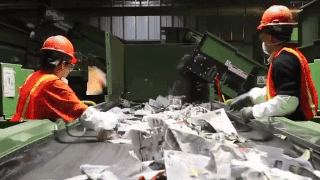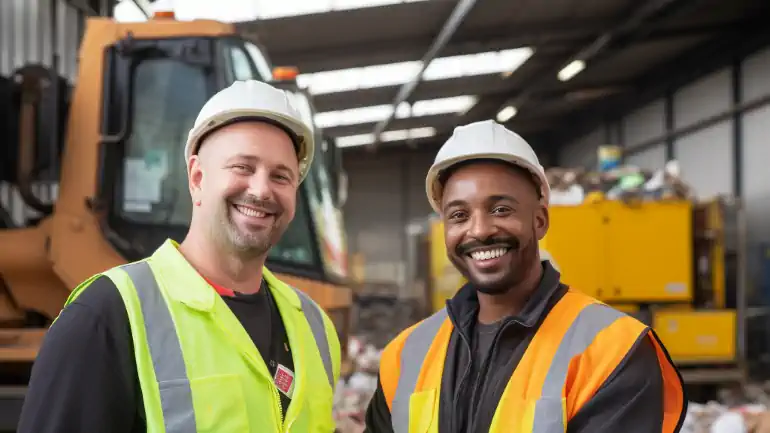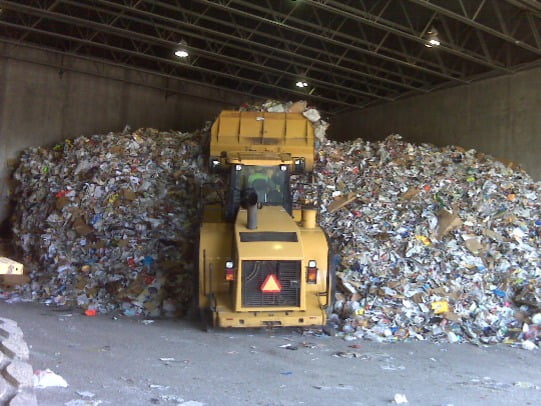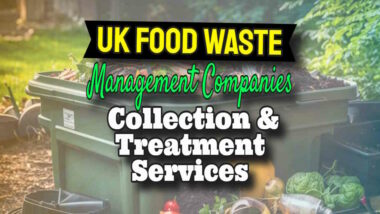What is a Waste Transfer Station? Well, let us explain Waste Transfer Stations, were once simply depots, often not even roofed where the dust carts (now called Refuse Collection Vehicles (RCVs)) would return after collecting each load of rubbish for their bin collection rounds. The RCVs would, and still do deposit their 3 to 5 tonnes of collected household and commercial waste, and return to their refuse collection rounds. But, nowadays a lot more than that happens to your waste!

Basic Waste Transfer Stations are in reality just conveniently situated depots where refuse collection vehicles (RCVs) discharge their loads to avoid collection vehicles travelling uneconomic and unnecessary distances to distant landfills.
The waste is picked up again and compacted into larger vehicles which may carry up to double the tonnage carried in each street collection truck (RCV).
This reduces vehicle mileage and traffic congestion, as well as avoiding collection operatives from riding unproductively in the cab while their vehicle travels long distances to landfill. The transfer station gets them back on to the collection round faster.
At the end of the day, the RCVs and bulk transport vehicles (bulkers) are usually all parked up in readiness for the next shift or the next day.
Apart from acting as a safe place to park the Council or the Waste Collection Contractor's vehicles overnight, their existence was originally just the pure economics of returning the bin round collection gangs back to work collecting as quickly as possible.
About half a dozen, to a dozen RCV loads would be needed to fill a bulk transport (truck). Each bulk transport truck will complete the round trip to the landfill and back each day. To send an RCV, with a gang of 4 or more relaxing on-board all the way to the tip makes no economic sense. It is only done when the landfill is very close to the collection round.
By transferring waste from local collection vehicles onto larger trailers or other transport modes such as barge and rail, the cost of transportation to distant disposal sites is significantly reduced. The transfer to rail and barges is more expensive, but this may be offset by lower charges for waste tipping at more distant rural landfills.
Although there are many Waste Transfer Stations which match the description we have just given, many have now become centres for waste reuse, and recycling.
What Takes Place in a Modern Waste Transfer Station
Typical activities at the waste transfer station involved the discharging of waste trucks, pre-screening, and elimination of unacceptable products (not suitable for landfill) such as car batteries, compacting, and afterwards refilling onto bigger transport vehicles, including trucks, trains, and barges to their final resting point in the local landfill site. In larger cities, the Waste Transfer Station may deliver their waste to an incinerator.
In city areas, the place of waste transfer terminals can be extremely hotly contested with residents seeking to avoid having one “in their backyard” (NIMBY syndrome). Such centres are consequently usually fully roofed with sealed walls, dust extraction and filtration systems, and automatic closing entrance doors.
Innovative waste sorting and also treatment equipment is currently installed at much bigger Waste Transfer Stations and the majority of them have currently been renamed as either MRFs and MBTs. Others are merely called Recycling Centres or Waste Hubs, others may be Incinerators (Waste to Energy Plants) etc.
Hazardous Waste Transfer Stations
Specialist waste materials such as hazardous waste and healthcare waste are not usually accepted at council-run transfer facilities.
Such waste streams are collected and transferred back to specialised hazardous waste transfer stations where the waste is sorted, segregated and bulked for ongoing transport to disposal, or re-use.
Waste Transfer Station Design and Regulation
Waste transfer stations are designed to maximise effective sorting and haulage. In addition, they are designed with the safety of the staff in mind.
Careful consideration of the environmental impact of each waste transfer site is taken at the design stage and must be regularly reviewed.
Most regulators constantly look for ways how this can be improved. Central and local government guidelines are published by the regulating authorities. These provide detailed guidance with regard to the best practice in operating waste transfer stations. Permits are issued, and no WTSs are allowed to operate without a current permit.
The regulatory authorities ensure all permits are up to date, and that regular reporting on emissions is undertaken and monitored.
Waste Transfer station staff are required to minimise harmful emissions at all times. This is done, for example, by spraying dusty waste materials with water to reduce particulates. Another way is to ensure that all vehicles on site avoid unnecessary engine idling.
Traffic management plans may need to be implemented to ensure the efficient flow of vehicles and reduce the turnaround times at waste transfer stations.
In principle, waste transfer stations are aimed primarily towards waste disposal. Recycling is a general aim, WTSs aren't normally set up to open bags (de-bag or depackage) and recycle to a high degree all of the waste that comes through. Most WTSs nowadays will be receiving kerbside segregated recyclables which they do, of course, keep out of the waste stream.
Waste Transfer Station Equipment
There is an array of specialist machinery and equipment used at these facilities.
Equipment ranges from the statutory weighbridge to equipment such as front-end loaders, conveyor belts, walking floors, and fixed and travelling cranes. Compactors are used universally and range from wheeled-compaction plants to container compactors which use a hydraulic ram to press the waste into ISO-style containers.
The Sequence of Operations in a WTS
There’s a standard process that all delivery trucks follow when arriving loaded at a scheduled stop.
1. Arrival
All vehicles are directed to a weighbridge when they arrive at the transfer station. They are weighed, plus tipping fees are applied when appropriate. If your community's household waste transfer station enables residents to hand over waste themselves, they may not be charged. There will usually be a separate gate-fee scale from the one applied to businesses when they dispose of their waste.
2. Dumping
Depending on the station, trucks will certainly dump trash either directly right into an additional lorry, onto the floor inside the building or into an open pit. When it's not moved directly onto a brand-new automobile, tools like cranes and also bulldozers relocate garbage around the centre.
3. Sorting/ Separation and Waste Treatment
If the waste transfer station is connected to a materials recycling facility, waste will be arranged and also evaluated to gather any type of recyclable things and also remove them from the waste stream. Employees will usually also do a screen for any kind of contaminated materials or unauthorised items to take care of independently.
Some facilities provide an area for members of the public to drop off green garden waste.
4. Compacting/ Reloading
After the waste has been sorted and also processed, compactors are used to increase just how much outgoing trailers can lug.
Solid waste can either be emptied into a pit, discharged onto the tipping floor or transferred directly to another vehicle. Waste is then packed onto a bigger transport vehicle and finally sent on to its next location at a landfill or incinerator.
Recyclables may be packed and exported overseas although this practice is denigrated.
Jobs at WTSs
A range of skilled and non-skilled jobs are available at waste transfer stations. These range from waste managers to customer service specialists, weighbridge operators, traffic controllers, and plant and equipment operators to run the facility from day to day.
Pickers are employed at conveyors, and may even be required in fully automated plants to ensure that unwanted objects are removed before they block up and stall the system, causing costly plant downtime.
Maintenance staff are also employed, such as mechanics, electricians and other technical experts. These are called in at regular intervals for monitoring and re-calibration of equipment, servicing, and in some instances, replenishment.
A fully operational WTS may employ 20 to 50 or more staff, in order to be fully operational.
Some WTSs deal in collection services for small mixed hazardous wastes. Those facilities that provide safe storage, segregation and transportation of hospital and clinical waste employ chemists.
These are specialist chemists trained in the safe classification of chemicals, packaging requirements, and collection of haz-waste, in accordance with the waste regulations. Such staff are particularly important to the Clinical Waste Transfer Station operators.

Commercially Operated Waste Transfer Stations
Commercial waste and some non-hazardous industrial wastes are commercially operated and provided that the operator obtains a suitable waste permit this is encouraged in most countries.
Many of the commercial operators specialise in Skip Waste. They Hire out skips and employ drivers to collect each skip by road, once it has been filled by the renter.
This part of the waste management business can be a great way for newcomers to start in the industry. If you are considering starting a skip-hire business, get a view of the way the industry works first. Accurately research the costs and legal requirements. Decide how many skips you can manage in a week. You will be required to recycle as much of your collected waste as possible.
However, once your staff become experts in this, it does provide a reasonable income, above the labour cost of sorting the waste. The secret to profit lies in the selection of profitable waste streams which will generate adequate income when sold.
Recycling markets are so volatile that flexibility is important. Reacting quickly to price drops for specific materials is important to ensure that only currently saleable materials are sorted from the waste and recycled.
MRFs and MBTs
When Transfer Stations incorporate sophisticated methods of treatment or handling such as sorting for recycling, pulverisation, resource recovery, incineration, composting etc, and are built to high standards of construction, the waste transfer function is less important.

So, they are now called MRFs (Materials Recovery Facilities), or in a slightly different form where the co-mingled and sometimes residual waste is also pre-treated before it leaves for the landfill. They are called MBT (Mechanical Biological Treatment) Plants and accept food waste for biological treatment. These new names much more readily describe the primary function of these facilities to reuse and recycle waste and pre-treat those waste streams that cannot be reused or recycled so that their impact in a landfill is reduced.
Refuse (Waste) Transfer Stations, as they were originally called, are so simple that the name is not an adequate term for what takes place at the modern facilities of today.
So, it would seem that in the UK and many other developed nations, few if any will be built in the future.
The name may be dying, but the transfer station function is still present and is now usually accomplished as a small part of the function of MRFs, MBT Plants and other waste technology plants.
FAQs
What is a Waste Transfer Station?
A Waste Transfer Station is a depot where refuse collection vehicles (RCVs) unload their collected household and commercial waste. This waste is compacted into larger vehicles for transport to landfills or other disposal facilities, minimizing unnecessary and uneconomic travel distances for collection vehicles.
What is the function of a modern Waste Transfer Station?
Modern Waste Transfer Stations function as centres for waste disposal, reuse, and recycling. They usually incorporate various stages, including waste unloading, pre-screening, sorting, compacting, and reloading onto larger transport vehicles. Some stations may also include materials recycling facilities or incinerators for waste treatment when they are renamed as Recycling Centres or MRFs.
What is the difference between MRFs, MBTs, and Waste Transfer Stations?
MRFs (Materials Recovery Facilities) and MBTs (Mechanical Biological Treatment Plants) are specific types of Waste Transfer Stations. MRFs focus on recovering recyclable materials from waste, while MBTs treat waste biologically, particularly food waste. Both of these facilities are more sophisticated and aim to maximize waste reuse and recycling.
Are there any special provisions for hazardous waste at Waste Transfer Stations?
Typically, hazardous waste and healthcare waste are not accepted at council-run Waste Transfer Stations. These types of waste are collected separately and transported to specialized hazardous waste transfer stations for sorting, segregation, and transport to disposal or re-use facilities.
How are Waste Transfer Stations regulated?
Waste Transfer Stations are regulated by central and local government guidelines. They must have a current permit to operate, and they are required to report regularly on emissions. Waste Transfer station staff are required to minimize harmful emissions, and the design of each station considers its environmental impact.
What jobs are available at Waste Transfer Stations?
Jobs at Waste Transfer Stations can range from waste managers, customer service specialists, weighbridge operators, traffic controllers, and plant and equipment operators, to maintenance staff such as mechanics and electricians. Some stations also employ chemists, particularly those dealing with hazardous waste.
What equipment is typically used at Waste Transfer Stations?
Waste Transfer Stations utilize various types of equipment, such as weighbridges, front-end loaders, conveyor belts, walking floors, cranes, and compactors. These are all integral to the operations of waste handling, sorting, and disposal.
What is the process for waste delivery at a Waste Transfer Station?
Upon arrival at a Waste Transfer Station, vehicles are directed to a weighbridge for weighing and application of appropriate tipping fees. Waste is then dumped onto the floor, into an open pit, or directly into another vehicle. It is moved around, sorted, processed, and compacted before being loaded onto larger transport vehicles for final disposal.
Article History: This article was first uploaded on 4 July 2008 and was re-written and updated in January 2020. FAQs Section added 1 August 2023.]






Fantastic insight into these ugly and noisy (smally) places where our rubbish goes. You did gain my attention, and there’s not too many websites around like yours.